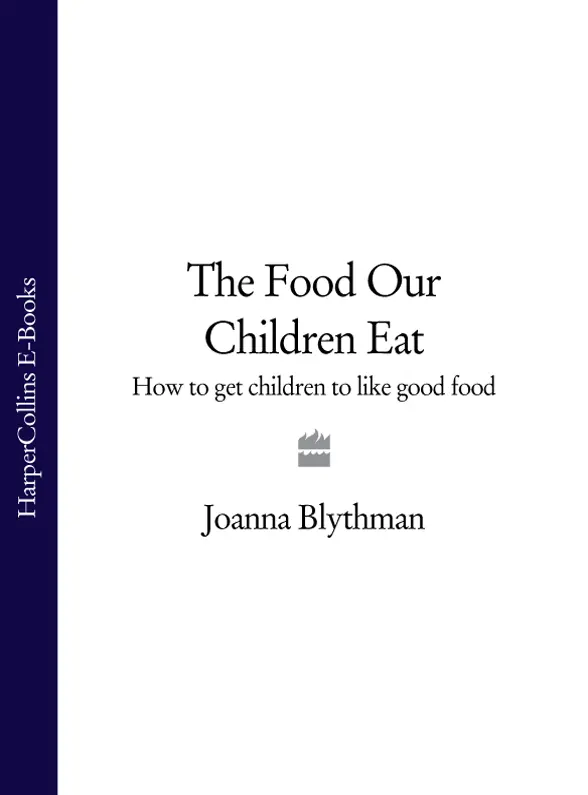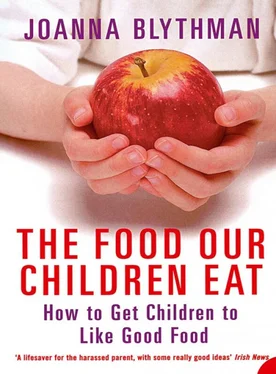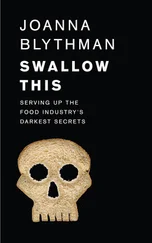
THE FOOD OUR
CHILDREN EAT
How to Get Children to Like Good Food
Cover
Title Page THE FOOD OUR CHILDREN EAT How to Get Children to Like Good Food
A few pages to read first
PART ONE: THE GHETTO OF ‘CHILDREN’S FOOD’
The modern ‘children’s diet’
‘Picky-eater’ culture
Parents’ attitudes
The rot begins with those little jars
Staggered eating
Sweets as food
Crisp crazy
The flickering screen
Gift-wrapped junk
Goodbye dinner lady, hello cash cafeteria
Child (un)friendly restaurants
PART TWO: BREAKING THE MOULD AT HOME
The real-food approach
Getting the message across
Spending priorities
The ‘tunnel effect’ and how to prevent it
Eating together and why it matters
The ‘never-satisfied’ snacker
Don’t keep food you don’t want children to eat
Presentation, boredom and the ‘yuck’ reaction
Sweets, treats and bans
Good food that children like
What children should drink
Healthier look-alike alternatives to common ‘children’s foods’
PART THREE: THE GENTLE ART OF PERSUASION
Dealing with children who say no
Avoiding the same old mistakes
Setting up a cooperative food relationship
Refining objections to food
Serving up praise by the bucketload
Making mealtimes work
The scope for insistence
Giving in gracefully but …
PART FOUR: GETTING IT RIGHT WITH BABIES AND TODDLERS
You know best
The essential blender
Introducing the world of food
Pesticide residue risks and the organic alternative
PART FIVE: INFLUENCING WHAT CHILDREN EAT WHEN YOU’RE NOT THERE
What you can expect from childcarers
Negotiating with nurseries and playgroups
The friend’s house
School food
PART SIX: TESTING SITUATIONS
Shopping tips
Car trips
Birthday parties
Grandparents’ houses
PART SEVEN: CONSOLIDATING YOUR EFFORTS
Encouraging children to cook
The fun and skill of food shopping
The fascinating world of restaurant food
Exercising junior tastebuds
PART EIGHT: NITTY-GRITTY IDEAS AND RECIPES FOR INSPIRATION
Twenty-five good snacks
Ten main courses that both adults and children like
Ten good drinks
Ten good packed lunches
Ten ways to get children to eat vegetables
Ten ideas for making eating more fun
Ten easy recipes that children can make
Appendix: Checklist of Additives to Avoid
Index
Acknowledgements
About the Author
Other Works
Copyright
About the Publisher
A FEW PAGES TO READ FIRST
This is a book for people who want their children to become adults with wide-ranging food tastes, adults who select a good diet for themselves and find pleasure in the process of eating.
Achieving such an outcome ought to be a straightforward matter, but these days children who fit this bill are something of an endangered species. Children no longer eat what adults eat. We now live in a world that assumes children must be catered for separately, from a repertoire of special ‘children’s foods’ designed to please their distinctive palate.
In the new millennium, perhaps sociologists and social historians will look back on the second half of the twentieth century and point to the emergence of this separate diet as a curious phenomenon. When you stop to think about it, it’s a huge watershed. For centuries children all over the world have been brought up to eat what their parents ate.
Traditionally, children’s food has always been inextricably linked with adult diet, right from day one. Children were breastfed – even if that meant finding a wet nurse.
Graduating on to more complex foods, they were fed ground-down, pulverised versions of what the extended family was eating. As soon as they had teeth and had become more independent, they ate whatever was produced in the kitchen in whatever form it emerged.
Now in many industrialised countries, and in the UK in particular, it’s more likely that children are tucking into a restricted number of specifically ‘children’s foods’. We are all too familiar with them. The working title ‘junk’ fits them as well as any other. But if we wanted to analyse that loaded term a little further, we might describe it as consisting of a small selection of highly processed, long-life foods – many technological interventions removed from their raw-food roots – heavily loaded with fat, sugar and salt.
Enter the ‘modern’ child and a typical food day. This might start with a bowl of highly refined cereal stuck together with sugar in one form or another, followed by a sweet drink and a packet of crisps for morning snack. Chips and custard might be the most popular canteen choice at lunchtime, or a protein and fat-based, vegetable-free sandwich in the lunch box, accompanied by sweets, a token apple (if you’re lucky) and often yet another packet of crisps. In the starving after-school interval, biscuits and more crisps fill the gap until an early ‘children’s teatime’, when out come the frozen Kievs, fish fingers, pizzas and burgers, destined to be scoffed with chips and copious amounts of ketchup and washed down by something sweet and fizzy. For pudding, there’s the sickly-sweet ‘kiddie’ yogurt with its lovable cartoon characters and child-friendly synthetic flavours. Not surprisingly, by bedtime they’re hungry again and it’s time for supper. That packet of cereal beckons once more, as do the biscuits.
The consequences of this change in our attitude towards child nutrition are so enormous that they are hard to grasp. We are embarked on an experiment with our children’s health that is unprecedented. This is a radical departure from the tried and tested way of nourishing children that societies have adopted since history began.
You don’t have to be a paediatrician to figure out that this sort of eating defies the laws of nutrition. Nearly every item has been processed out of its natural form. It is top-heavy on ingredients we know cause health problems long-term and notoriously short on those that keep the human body healthy: whole, unprocessed plant foods, especially fruit and vegetables. So we are living through a strange irony. Instead of being given the best food available, as they ought to be, children are being given the worst.
It is going to take time for the impact of this major change in eating patterns to show through but initial indications are not good. Worrying tales have emerged from the US, where doctors have been shocked by the premature furring up of arteries that has inadvertently come to light when children have been admitted to hospital as road casualties.
Teachers complain that their pupils’ concentration span is not what it should be because they are going from one quick sugary snack to another and simply don’t have the stamina that a long, slow release of nutrients from a balanced diet would give them. According to the World Health Organisation, ‘The prevalence of overweight and obesity is increasing worldwide at an alarming rate … Moreover, as the problem appears to be increasing rapidly in children as well as adults, the truth health consequences may only become fully apparent in the distant future.’
Читать дальше












